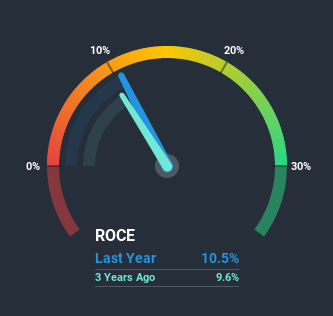The Returns On Capital At Excelsior Capital (ASX:ECL) Don't Inspire Confidence

What underlying fundamental trends can indicate that a company might be in decline? A business that's potentially in decline often shows two trends, a return on capital employed (ROCE) that's declining, and a base of capital employed that's also declining. This combination can tell you that not only is the company investing less, it's earning less on what it does invest. Having said that, after a brief look, Excelsior Capital (ASX:ECL) we aren't filled with optimism, but let's investigate further.
What is Return On Capital Employed (ROCE)?
For those who don't know, ROCE is a measure of a company's yearly pre-tax profit (its return), relative to the capital employed in the business. Analysts use this formula to calculate it for Excelsior Capital:
Return on Capital Employed = Earnings Before Interest and Tax (EBIT) ÷ (Total Assets - Current Liabilities)
0.11 = AU$5.3m ÷ (AU$60m - AU$9.6m) (Based on the trailing twelve months to December 2019).
Therefore, Excelsior Capital has an ROCE of 11%. On its own, that's a standard return, however it's much better than the 8.5% generated by the Electrical industry.
Check out our latest analysis for Excelsior Capital
Historical performance is a great place to start when researching a stock so above you can see the gauge for Excelsior Capital's ROCE against it's prior returns. If you'd like to look at how Excelsior Capital has performed in the past in other metrics, you can view this free graph of past earnings, revenue and cash flow.
The Trend Of ROCE
In terms of Excelsior Capital's historical ROCE movements, the trend doesn't inspire confidence. Unfortunately the returns on capital have diminished from the 15% that they were earning five years ago. Meanwhile, capital employed in the business has stayed roughly the flat over the period. Since returns are falling and the business has the same amount of assets employed, this can suggest it's a mature business that hasn't had much growth in the last five years. So because these trends aren't typically conducive to creating a multi-bagger, we wouldn't hold our breath on Excelsior Capital becoming one if things continue as they have.
The Bottom Line On Excelsior Capital's ROCE
In summary, it's unfortunate that Excelsior Capital is generating lower returns from the same amount of capital. In spite of that, the stock has delivered a 31% return to shareholders who held over the last five years. Either way, we aren't huge fans of the current trends and so with that we think you might find better investments elsewhere.
Excelsior Capital does come with some risks though, we found 3 warning signs in our investment analysis, and 1 of those is potentially serious...
For those who like to invest in solid companies, check out this free list of companies with solid balance sheets and high returns on equity.
This article by Simply Wall St is general in nature. It does not constitute a recommendation to buy or sell any stock, and does not take account of your objectives, or your financial situation. We aim to bring you long-term focused analysis driven by fundamental data. Note that our analysis may not factor in the latest price-sensitive company announcements or qualitative material. Simply Wall St has no position in any stocks mentioned.
Have feedback on this article? Concerned about the content? Get in touch with us directly. Alternatively, email editorial-team@simplywallst.com.


